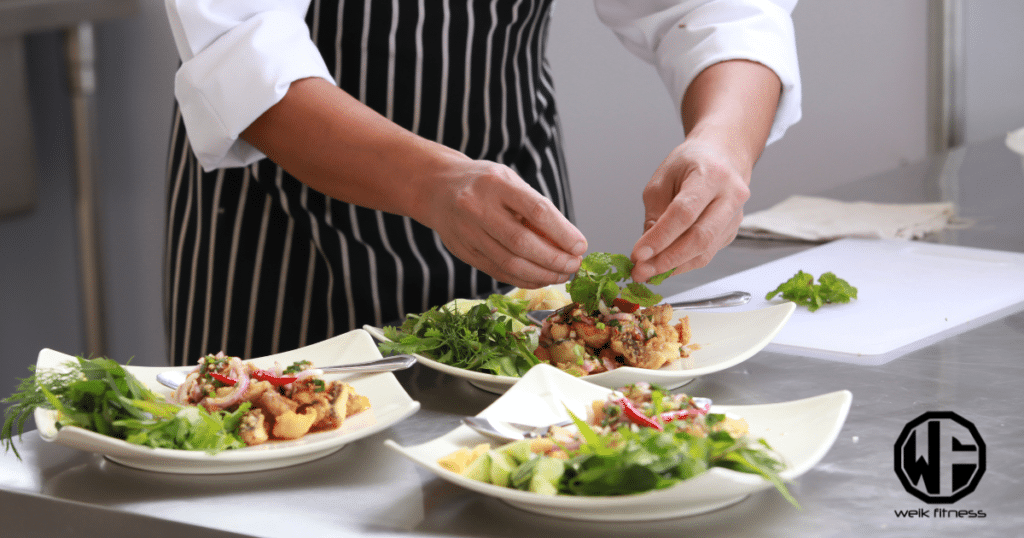How to Easily Make Healthier Choices Ordering at Restaurants
Loving the experience of eating out at restaurants but hating the feeling of being overly full afterward is a common struggle. How many times have you left a restaurant only to unbutton your pants for the ride home? As a certified sports nutritionist, I can tell you it doesn’t have to be this way when ordering at restaurants.
You can absolutely enjoy delicious food and great company without the regret of overeating. The key is knowing how to make smarter, healthier choices when ordering at restaurants.
This guide will break down the simple, actionable tips I share with my clients to help them navigate any menu with confidence. You’ll learn how to enjoy the entire experience, feel great afterward, and stay on track with your weight loss goals.
Disclaimer: This article is for informational purposes only and is not meant to treat or diagnose any condition. It is recommended that you speak with your doctor before starting any exercise program, changing your daily nutrition, or adding any supplements to your regimen.
Table of contents
Key Takeaways
- Plan Ahead: Never arrive at a restaurant starving. Look up the menu online beforehand to make a smart choice without pressure.
- Control Portions: Restaurant portions are often two to three times the recommended serving size. Ask for a to-go box immediately and put half your meal away for later.
- Ask Questions: Don’t hesitate to ask how a dish is prepared. Requesting that food be steamed, grilled, or baked instead of fried, and asking for sauces on the side, can save hundreds of calories.
- Track Your Intake: Use a nutrition app like MyFitnessPal or Cronometer to log your meal and see how it fits into your daily calorie goals.

How to Make Healthier Choices When Ordering at Restaurants
Just because you’re eating out doesn’t mean you have to sabotage your weight loss progress. These proven strategies will help you enjoy your meal while staying in control.
1. Eat Your Normal Meals Throughout the Day
You’ve probably heard that you should never go grocery shopping on an empty stomach. The same exact rule applies to dining out. Arriving at a restaurant when you’re starving is a recipe for disaster. Everything on the menu will look irresistible, and you’ll be far more likely to over-order and overeat.
When you skip meals, your body increases the production of ghrelin, often called the “hunger hormone.” This hormonal surge significantly boosts your appetite, making it difficult to make rational, healthy choices.
To avoid this, stick to your regular eating schedule. If you have a dinner reservation, make sure you have a balanced breakfast and lunch. A small, protein-rich snack like a Greek yogurt or a handful of almonds about an hour before you go can also help curb extreme hunger, allowing you to order with your head, not your stomach.
2. Know Where You’re Going and What’s on the Menu

Walking into a restaurant without a plan is like walking onto a battlefield unarmed. You can gain a massive advantage by simply checking the menu online before you leave the house. Studies have shown that meal planning is associated with a healthier diet and better weight management.
Most major restaurant chains, from Nando’s to Bella Italia, provide full nutritional information on their websites. This allows you to identify healthier options in advance and decide what you’re going to order before you’re influenced by the tempting descriptions or what others at the table are having.
Look for menu sections labeled “light,” “healthy,” or “under 600 calories.” Planning ahead empowers you to make a choice that aligns with your goals, so you can relax and enjoy the social aspect of dining out.
3. Don’t Be Afraid to Order What You REALLY Want
This might sound counterintuitive, but forcing yourself to order a plain salad when you’re craving a burger often backfires. Healthy eating is about balance, not deprivation. If you plan for it, you can absolutely fit your favorite foods into your weight loss plan.
Related Article: Need A Quick Meal? Grab Food from a Made-to-Order Restaurant
This is where technology becomes your best friend. A powerful app like MyFitnessPal, which has one of the largest food databases available, lets you pre-log your restaurant meal. You can see exactly how that burger or pasta dish fits into your daily calorie and macro targets.
Other excellent apps can also help you stay on track.
- Cronometer: This is my personal favorite for clients focused on micronutrients, as it tracks over 80 different vitamins and minerals, not just calories and macros.
- Lose It!: This app features a massive database of over 50 million foods and has a unique “Snap It” feature that lets you log food by taking a picture of it.
Using MyFitnessPal or another tracker transforms ordering at restaurants from a guessing game into a calculated part of your successful nutrition strategy.
4. Ask How Food is Prepared and Make Special Requests
One of the biggest reasons food tastes so good at restaurants is the generous use of butter, oil, and salt. While delicious, these “hidden” ingredients can add hundreds of extra calories to an otherwise healthy dish. A single tablespoon of oil, for example, contains around 120 calories.

Never feel shy about asking your server questions or making special requests. You are the customer, and most kitchens are happy to accommodate. In my experience as a trainer, this is one of the most underutilized but effective strategies.
Pro Tip: Use simple, clear language when ordering. Try these phrases:
• “Could I get the vegetables steamed with no butter?”
• “Can the chicken be grilled instead of fried?”
• “Could you please put the dressing on the side?”
Related Article: 7 Tips to Restaurant Eating without Regret
Simply asking for sauces, dressings, or gravy on the side gives you complete control over how much you use, which can drastically reduce the final calorie count of your meal.
5. Drink Water or Keep Liquid Calories to a Minimum
Liquid calories are one of the sneakiest ways to derail your diet when ordering at restaurants. Sugary sodas, juices, and alcoholic beverages can add up incredibly fast. For example, a single margarita can pack over 300 calories.
Sticking with water is your best bet for hydration without calories. Research also shows that drinking a full glass of water before your meal arrives can help you feel fuller and naturally eat less. If you want some flavor, ask for a lemon or lime wedge.

If you do opt for another beverage, choose wisely. Unsweetened iced tea, black coffee, and diet sodas are all zero-calorie options. Ask yourself: would you rather eat 500 calories of satisfying food or drink 500 empty calories?
6. Split Your Meal in Half
This is arguably the most powerful tip for healthy eating at restaurants. Portion sizes have exploded over the past few decades; according to the CDC, some are now two to three times larger than they were in the 1950s. A typical restaurant meal can contain over 1,200 calories, which is a significant portion of an entire day’s needs for many people.
Don’t fall into the trap of feeling like you have to clean your plate. Instead, take control of the portion size from the start.
Here’s the game plan: the moment your food arrives, ask your server for a to-go box. Before you take a single bite, divide everything on your plate in half and pack one half away. This simple action has two incredible benefits:
- You instantly cut the calories of your meal in half, making it much easier to fit into your nutrition plan.
- You now have a delicious, already-prepared lunch for the next day. It’s two meals for the price of one!
7. Share a Dessert

Yes, you can have dessert! I’m not here to tell you to avoid all the fun foods. If you’ve planned your meal, managed your portion size, and have room in your daily calorie budget, you can certainly enjoy a treat.
The key is moderation. Restaurant desserts are often massive and calorie-dense. For instance, a single slice of cheesecake can easily exceed 800 calories. The best strategy is to share. Order one dessert for the table and have a few satisfying bites.
If you’re dining alone, apply the same principle as your main course. Ask for half of the dessert to be boxed up to take home right away. This way, you get to enjoy a delicious treat from your favorite restaurant on two separate occasions.
Go Enjoy Yourself When Ordering at Restaurants!
Use these tips the next time you’re ordering at restaurants to protect your waistline and feel great. The most important thing to remember is that you have choices.
You can enjoy the company of friends and family with a fantastic meal away from home.
Dining out can be a guilt-free part of your healthy lifestyle without leading to regret or weight gain. Now, go out there and enjoy yourself!
Healthy Ordering at Restaurants FAQs
What is the healthiest type of restaurant to eat at?
While you can find healthy options almost anywhere, some cuisines are generally easier to navigate. A Tufts University study found that Greek, Japanese, and Vietnamese restaurants tended to have the lowest average calorie counts per meal. Restaurants that emphasize fresh ingredients, like farm-to-table or Mediterranean spots, are also excellent choices.
Are salads always a healthy choice?
Not always. Many restaurant salads are loaded with high-calorie additions like creamy dressings, fried chicken, bacon, and large amounts of cheese, which can make them less healthy than a simple grilled chicken sandwich. To keep your salad healthy, opt for a vinaigrette-based dressing on the side and choose grilled protein over fried options.
How can I handle social pressure to eat more?
This is a common challenge. It helps to decide on your plan before you go. If friends are ordering multiple appetizers, you can politely decline or suggest a lighter option to share. Focus on the conversation and the company rather than making food the central point. Remember, your health goals are your own, and you don’t need to justify your choices to anyone.
What are some easy, healthy swaps I can make?
Simple substitutions can make a huge difference. Here are a few to try:
- Swap fries for a side salad or steamed vegetables.
- Choose grilled, baked, or steamed proteins instead of fried.
- Ask for whole-wheat bread or pasta if available.
- Opt for tomato-based sauces (like marinara) instead of cream-based ones (like alfredo).


*Disclosure: This article may contain affiliate links or ads, which means we earn a small commission at no extra cost to you if you make a purchase through these links. These commissions help support the operation and maintenance of our website, allowing us to continue producing free valuable content. Your support is genuinely appreciated, whether you choose to use our links or not. Thank you for being a part of our community and enjoying our content.
PLEASE CONSIDER SHARING THIS ON YOUR SOCIAL MEDIA TO HELP OTHERS LEARN MORE ABOUT THIS TOPIC.





